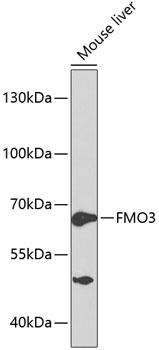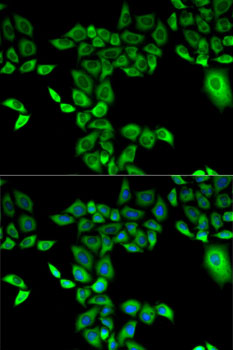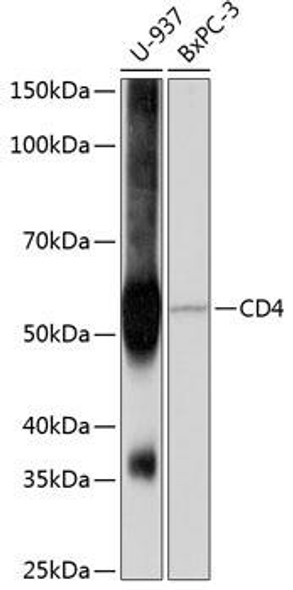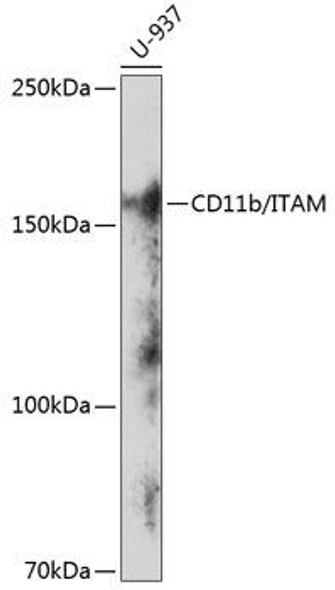Cell Biology Antibodies 7
Anti-FMO3 Antibody (CAB1901)
- SKU:
- CAB1901
- Product Type:
- Antibody
- Reactivity:
- Human
- Reactivity:
- Mouse
- Host Species:
- Rabbit
- Isotype:
- IgG
- Research Area:
- Cell Biology
Description
| Antibody Name: | Anti-FMO3 Antibody |
| Antibody SKU: | CAB1901 |
| Antibody Size: | 20uL, 50uL, 100uL |
| Application: | WB IF |
| Reactivity: | Human, Mouse |
| Host Species: | Rabbit |
| Immunogen: | Recombinant fusion protein containing a sequence corresponding to amino acids 263-532 of human FMO3 (NP_001002294.1). |
| Application: | WB IF |
| Recommended Dilution: | WB 1:500 - 1:2000 IF 1:10 - 1:100 |
| Reactivity: | Human, Mouse |
| Positive Samples: | Mouse liver |
| Immunogen: | Recombinant fusion protein containing a sequence corresponding to amino acids 263-532 of human FMO3 (NP_001002294.1). |
| Purification Method: | Affinity purification |
| Storage Buffer: | Store at -20'C. Avoid freeze / thaw cycles. Buffer: PBS with 0.02% sodium azide, 50% glycerol, pH7.3. |
| Isotype: | IgG |
| Sequence: | RFKH ENYG LMPL NGVL RKEP VFND ELPA SILC GIVS VKPN VKEF TETS AIFE DGTI FEGI DCVI FATG YSFA YPFL DESI IKSR NNEI ILFK GVFP PLLE KSTI AVIG FVQS LGAA IPTV DLQS RWAA QVIK GTCT LPSM EDMM NDIN EKME KKRK WFGK SETI QTDY IVYM DELS SFIG AKPN IPWL FLTD PKLA MEVY FGPC SPYQ FRLV GPGQ WPGA RNAI LTQW DRSL KPMQ TRVV GRLQ KPCF FFHW LKLF AIPI LLIA VFLV LT |
| Gene ID: | 2328 |
| Uniprot: | P31513 |
| Cellular Location: | Endoplasmic reticulum membrane, Microsome membrane |
| Calculated MW: | 60kDa |
| Observed MW: | 68kDa |
| Synonyms: | FMO3, FMOII, TMAU, dJ127D3.1 |
| Background: | Flavin-containing monooxygenases (FMO) are an important class of drug-metabolizing enzymes that catalyze the NADPH-dependent oxygenation of various nitrogen-, sulfur-, and phosphorous-containing xenobiotics such as therapeutic drugs, dietary compounds, pesticides, and other foreign compounds. The human FMO gene family is composed of 5 genes and multiple pseudogenes. FMO members have distinct developmental- and tissue-specific expression patterns. The expression of this FMO3 gene, the major FMO expressed in adult liver, can vary up to 20-fold between individuals. This inter-individual variation in FMO3 expression levels is likely to have significant effects on the rate at which xenobiotics are metabolised and, therefore, is of considerable interest to the pharmaceutical industry. This transmembrane protein localizes to the endoplasmic reticulum of many tissues. Alternative splicing of this gene results in multiple transcript variants encoding different isoforms. Mutations in this gene cause the disorder trimethylaminuria (TMAu) which is characterized by the accumulation and excretion of unmetabolized trimethylamine and a distinctive body odor. In healthy individuals, trimethylamine is primarily converted to the non odorous trimethylamine N-oxide. |
| UniProt Protein Function: | FMO3: Involved in the oxidative metabolism of a variety of xenobiotics such as drugs and pesticides. It N-oxygenates primary aliphatic alkylamines as well as secondary and tertiary amines. Plays an important role in the metabolism of trimethylamine (TMA), via the production of TMA N-oxide (TMAO). Is also able to perform S-oxidation when acting on sulfide compounds. Defects in FMO3 are the cause of trimethylaminuria (TMAU); also known as fish-odor syndrome. TMAU is an inborn error of metabolism associated with an offensive body odor and caused by deficiency of FMO-mediated N-oxidation of amino- trimethylamine (TMA) derived from foodstuffs. Such individuals excrete relatively large amounts of TMA in their urine, sweat, and breath, and exhibit a fishy body odor characteristic of the malodorous free amine. Belongs to the FMO family. |
| UniProt Protein Details: | Protein type:EC 1.14.13.148; Xenobiotic Metabolism - drug metabolism - cytochrome P450; Oxidoreductase; EC 1.14.13.8 Chromosomal Location of Human Ortholog: 1q24.3 Cellular Component: endoplasmic reticulum membrane; intracellular membrane-bound organelle; integral to membrane Molecular Function:amino acid binding; FAD binding; NADP binding; flavin-containing monooxygenase activity Biological Process: xenobiotic metabolic process; drug metabolic process Disease: Trimethylaminuria |
| NCBI Summary: | Flavin-containing monooxygenases (FMO) are an important class of drug-metabolizing enzymes that catalyze the NADPH-dependent oxygenation of various nitrogen-,sulfur-, and phosphorous-containing xenobiotics such as therapeutic drugs, dietary compounds, pesticides, and other foreign compounds. The human FMO gene family is composed of 5 genes and multiple pseudogenes. FMO members have distinct developmental- and tissue-specific expression patterns. The expression of this FMO3 gene, the major FMO expressed in adult liver, can vary up to 20-fold between individuals. This inter-individual variation in FMO3 expression levels is likely to have significant effects on the rate at which xenobiotics are metabolised and, therefore, is of considerable interest to the pharmaceutical industry. This transmembrane protein localizes to the endoplasmic reticulum of many tissues. Alternative splicing of this gene results in multiple transcript variants encoding the same protein. Mutations in this gene cause the disorder trimethylaminuria (TMAu) which is characterized by the accumulation and excretion of unmetabolized trimethylamine and a distinctive body odor. In healthy individuals, trimethylamine is primarily converted to the non odorous trimethylamine N-oxide.[provided by RefSeq, Aug 2009] |
| UniProt Code: | P31513 |
| NCBI GenInfo Identifier: | 6166183 |
| NCBI Gene ID: | 2328 |
| NCBI Accession: | P31513.5 |
| UniProt Secondary Accession: | P31513,Q14854, Q8N5N5, B2R816, |
| UniProt Related Accession: | P31513 |
| Molecular Weight: | 60,033 Da |
| NCBI Full Name: | Dimethylaniline monooxygenase |
| NCBI Synonym Full Names: | flavin containing monooxygenase 3 |
| NCBI Official Symbol: | FMO3 |
| NCBI Official Synonym Symbols: | TMAU; FMOII; dJ127D3.1 |
| NCBI Protein Information: | dimethylaniline monooxygenase [N-oxide-forming] 3; dimethylaniline monooxygenase [N-oxide-forming] 3; FMO 3; FMO II; FMO form 2; dimethylaniline oxidase 3; trimethylamine monooxygenase; hepatic flavin-containing monooxygenase 3; hepatic flavin-containing monooxygenase-3 |
| UniProt Protein Name: | Dimethylaniline monooxygenase [N-oxide-forming] 3 |
| UniProt Synonym Protein Names: | Dimethylaniline oxidase 3; FMO II; FMO form 2; Hepatic flavin-containing monooxygenase 3; FMO 3; Trimethylamine monooxygenase (EC:1.14.13.148) |
| Protein Family: | Dimethylaniline monooxygenase |
| UniProt Gene Name: | FMO3 |
| UniProt Entry Name: | FMO3_HUMAN |
View AllClose








